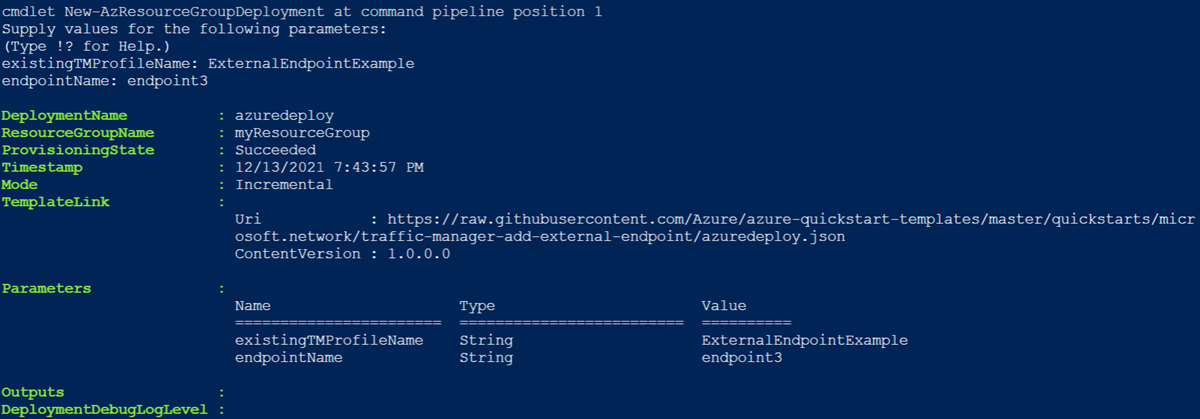本文介绍如何使用 Azure 资源管理器模板(ARM 模板)将外部终结点添加到现有流量管理器配置文件。
Azure 资源管理器模板是定义项目基础结构和配置的 JavaScript 对象表示法 (JSON) 文件。 模板使用声明性语法。 你可以在不编写用于创建部署的编程命令序列的情况下,描述预期部署。
如果你的环境满足先决条件,并且你熟悉如何使用 ARM 模板,请选择“部署到 Azure”按钮。 Azure 门户中会打开模板。
如果没有 Azure 订阅,请在开始前创建一个试用版订阅。
现有的 Azure 流量管理器配置文件。 若要详细了解如何创建 Azure 流量管理器配置文件,请参阅快速入门:使用 ARM 模板创建流量管理器配置文件。
本快速入门中使用的模板来自 Azure 快速启动模板。
{
"$schema": "https://schema.management.azure.com/schemas/2019-04-01/deploymentTemplate.json#",
"contentVersion": "1.0.0.0",
"parameters": {
"existingTMProfileName": {
"type": "string",
"metadata": {
"description": "Name of the traffic manager profile to add a endpoint to"
}
},
"endpointName": {
"type": "string",
"metadata": {
"description": "Name of the endpoint to add to traffic manager profile"
}
}
},
"variables": {
"endpointStatus": "Enabled",
"endpointMonitorStatus": "Degraded",
"endpointLocation": "chinanorth",
"target": "www.msn.com",
"weight": "3",
"priority": "3"
},
"resources": [
{
"apiVersion": "2018-04-01",
"type": "Microsoft.Network/TrafficManagerProfiles/ExternalEndpoints",
"name": "[concat(parameters('existingTMProfileName'), '/', parameters('endpointName'))]",
"properties": {
"endpointStatus": "[variables('endpointStatus')]",
"endpointLocation": "[variables('endpointLocation')]",
"endpointMonitorStatus": "[variables('endpointMonitorStatus')]",
"target": "[variables('target')]",
"weight": "[variables('weight')]",
"priority":"[variables('priority')]"
}
}
]
}
模板中定义了一个 Azure 资源:
若要查找与 Azure 流量管理器相关的更多模板,请参阅 Azure 快速入门模板。
选择
Deploy to Azure China以在由世纪互联运营的 Azure 上部署模板。注意
必须修改从 GitHub 存储库“azure-quickstart-templates”下载或参考的模板,以适应由世纪互联运营的 Azure 环境。 例如,替换某些终结点(将“blob.core.windows.net”替换为“blob.core.chinacloudapi.cn”,将“cloudapp.azure.com”替换为“cloudapp.chinacloudapi.cn”);必要时更改某些不受支持的位置、VM 映像、VM 大小、SKU 以及资源提供程序的 API 版本。
在本文中,请在 Azure 门户中选择“编辑模板”,并将 endpointLocation 的值替换为“变量”属性中的实际中国区域参数,然后选择“保存”按钮。
输入相应的值。
模板部署会根据输入将另一个终结点添加到现有配置文件。
资源组名称是包含现有配置文件的现有资源组。
注意
existingTMProfileName 必须与现有配置文件名称匹配才能成功部署模板。 如果部署失败,请从步骤 1 重新开始。
部署模板需要几分钟时间。 完成后,输出类似于:

使用 Azure PowerShell 部署模板。 除了 Azure PowerShell,还可以使用 Azure 门户、Azure CLI 和 REST API。 若要了解其他部署方法,请参阅部署模板。
使用 Get-AzTrafficManagerProfile 验证是否向配置文件添加了另一个终结点。
Get-AzTrafficManagerProfile -ResourceGroupName myResourceGroup -Name ExternalEndpointExample | Select Endpoints输出类似于:

如果不再需要流量管理器配置文件,请删除资源组。 此命令删除流量管理器配置文件和所有相关资源。
若要删除资源组,请调用 Remove-AzResourceGroup cmdlet:
Remove-AzResourceGroup -Name <your resource group name>
在本快速入门中,你向现有流量管理器配置文件添加了一个终结点。
若要详细了解如何路由流量,请继续学习流量管理器教程。

